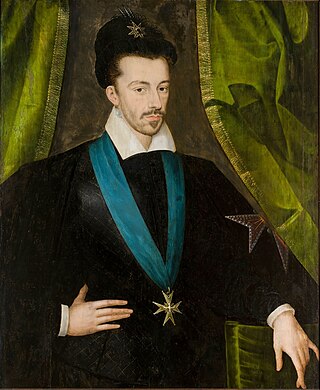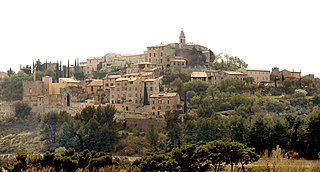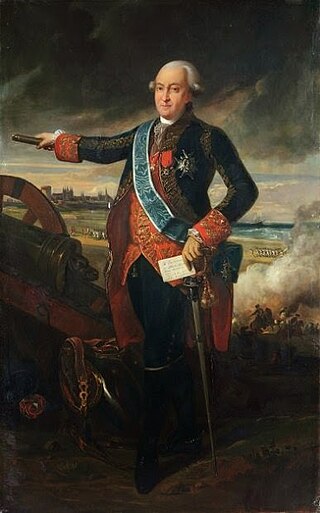
The Capetian House of Valois was a cadet branch of the Capetian dynasty. They succeeded the House of Capet to the French throne, and were the royal house of France from 1328 to 1589. Junior members of the family founded cadet branches in Orléans, Anjou, Burgundy, and Alençon.

Charles IX was King of France from 1560 until his death in 1574. He ascended the French throne upon the death of his brother Francis II in 1560, and as such was the penultimate monarch of the House of Valois.

Henry III was King of France from 1574 until his assassination in 1589, as well as King of Poland and Grand Duke of Lithuania from 1573 to 1575.

The French Wars of Religion were a series of civil wars between French Catholics and Protestants from 1562 to 1598. Between two and four million people died from violence, famine or disease directly caused by the conflict, and it severely damaged the power of the French monarchy. One of its most notorious episodes was the St. Bartholomew's Day massacre in 1572. The fighting ended with a compromise in 1598, when Henry of Navarre, who had converted to Catholicism in 1593, was proclaimed King Henry IV of France and issued the Edict of Nantes, which granted substantial rights and freedoms to the Huguenots. However, Catholics continued to disapprove of Protestants and of Henry, and his assassination in 1610 triggered a fresh round of Huguenot rebellions in the 1620s.

Henri I de Lorraine, Duke of Guise, Prince of Joinville, Count of Eu, sometimes called Le Balafré ('Scarface'), was the eldest son of François, Duke of Guise, and Anna d'Este. His maternal grandparents were Ercole II d'Este, Duke of Ferrara, and Renée of France. Through his maternal grandfather, he was a descendant of Lucrezia Borgia and Pope Alexander VI.

François de Lorraine, 2nd Duke of Guise, 1st Prince of Joinville, and 1st Duke of Aumale, was a French general and statesman. A prominent leader during the Italian War of 1551–1559 and French Wars of Religion, he was assassinated during the siege of Orleans in 1563.
The War of the Three Henrys, also known as the Eighth War of Religion, took place during 1585–1589, and was the eighth conflict in the series of civil wars in France known as the French Wars of Religion. It was a three-way war fought between:

Odo IV or Eudes IV was Duke of Burgundy from 1315 until his death and Count of Burgundy and Artois between 1330 and 1347, as well as titular King of Thessalonica from 1316 to 1320. He was the second son of Duke Robert II and Agnes of France.

Charles of Blois-Châtillon, nicknamed "the Saint", was the legalist Duke of Brittany from 1341 until his death, via his marriage to Joan, Duchess of Brittany and Countess of Penthièvre, holding the title against the claims of John of Montfort. The cause of his possible canonization was the subject of a good deal of political maneuvering on the part of his cousin, Charles V of France, who endorsed it, and his rival, Montfort, who opposed it. The cause fell dormant after Pope Gregory XI left Avignon in 1376, but was revived in 1894. Charles of Blois was beatified in 1904.

François de Bonne, duc de Lesdiguières was a French soldier of the French Wars of Religion and Constable of France, and one of only six Marshals to have been promoted Marshal General of France.

Jacques de Savoie, duc de Nemours was a French military commander, governor and Prince Étranger. Having inherited his titles at a young age, Nemours fought for king Henri II during the latter Italian Wars, seeing action at the siege of Metz and the stunning victories of Renty and Calais in 1554 and 1558. Already a commander of French infantry, he received promotion to commander of the light cavalry after the capture of Calais in 1558. A year prior he had accompanied François, Duke of Guise on his entry into Italy, as much for the purpose of campaigning as to escape the king's cousin Antoine of Navarre who was threatening to kill him for his extra-marital pursuit of Navarre's cousin.

Crillon-le-Brave is a commune in the Vaucluse department in the Provence-Alpes-Côte d'Azur region of Southeastern France. In 2019, it had a population of 475.

Chieri is a town and comune in the Metropolitan City of Turin, Piedmont (Italy), located about 11 kilometres southeast of Turin, 15 km (9 mi) by rail and 13 km (8 mi) by road. It borders the following municipalities: Baldissero Torinese, Pavarolo, Montaldo Torinese, Pino Torinese, Arignano, Andezeno, Pecetto Torinese, Riva presso Chieri, Cambiano, Santena, and Poirino.
Arthur Dillon, Count Dillon (1670–1733) was a Jacobite soldier from Ireland who served as colonel of Dillon's Regiment in the Irish Brigade in French service. He fought in the Nine Years' War and in the War of the Spanish Succession where he excelled at the Battle of Cremona against Prince Eugene of Savoy.

Louis des Balbes de Berton de Crillon, 1st Duke of Mahón was a French-born military officer and nobleman who reached the rank of Captain general of the Army. He became a soldier at the age of 16 and served with distinction in the French Royal Army before transferring to the Spanish Army, which was allied with France for much of the 18th century. A member of a distinguished military family, he was widely admired for his personal courage, courtesy, and chivalry. By the end of his life he had risen to the highest military rank in Spain and it was said that he had served in 68 engagements.
Berton is a both a surname and a given name. Notable people with the name include:

The Hôtel d'Europe is a five-star hotel located in the old historical part of Avignon, in Provence, France. It has been a hotel since 1799 and is considered one of the oldest hotels in France.
The House of Balbo Bertone is a Piedmontese family that held a preeminent position in the politics of medieval and early Renaissance Chieri, a Piedmontese city republic within the Holy Roman Empire, which starting from the late eleventh century struggled for independence from its Imperial liege overlords: at various times the Bishops of Turin, the Counts of Biandrate, and the Marquis of Montferrat. As the city grew in power and prosperity, it became with its sister Republic of Asti an important centre of commerce on the trade route from Genova and Italy to France, up until the 15th century. It was then incorporated completely into the County of Savoy and lost its independence.

Entry of Henry IV into Paris is an oil on canvas history painting by the French artist Francois Gérard, from 1817. It is held at the Galerie des Batailles, in the Palace of Versailles.















